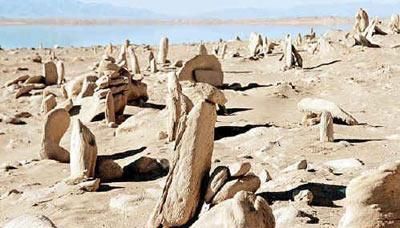Baigong Pipes are a series of pipe-like features found on and near Mount Baigong, about 40 km southwest of the city of Delingha, in the Haixi Mongol and Tibetan Autonomous Prefecture, Qinghai Province, China.
There are three caves in Mount Baigong and mouths of the two smaller caves have collapsed. Only the largest cave, which is 6 meters (18 feet) high, can be entered.
 Mount Baigong’s caves contain hundreds of rustic iron pipes. Some of the pipes run deep into the mountain, others run to a nearby lake toson. There are more pipes in the lake bottom and there are pipes scattered along the shoreline. The pipes are cleanly cut and not jagged, so they appear to have had a use at one time. This all seems mundane: some pipes sticking out of the ground in China, but archeologists dated the pipes to a time when humanity was just getting familiar with fire, making casting iron impossible.
Mount Baigong’s caves contain hundreds of rustic iron pipes. Some of the pipes run deep into the mountain, others run to a nearby lake toson. There are more pipes in the lake bottom and there are pipes scattered along the shoreline. The pipes are cleanly cut and not jagged, so they appear to have had a use at one time. This all seems mundane: some pipes sticking out of the ground in China, but archeologists dated the pipes to a time when humanity was just getting familiar with fire, making casting iron impossible.
Some ufologists think that the pipes were part of some sort of UFO landing site or alien complex. They cite that the pipes contain silica, which is also found on Mars, as evidence, but it is important to note that silica can be found in lots of cast iron materials. What purpose did these pipes serve and who put them there ?
 Additional Baigong Pipes were found on shore and within Toson Lake, which lies 80 meters (260 feet) from the mouth of the largest cave. On the beach of Lake Toson, about 40 meters (130 feet) from the mouth of the largest cave, apparently flat-lying, hollow, pipe-like features were found. These reddish-brown pipe-like features range in diameter from 2 to 4.5 cm (0.8 to 1.8 inch) and have an east-west orientation. Another group of pipe-like features, presumably vertical, either protrude from or lie just below the surface of the lake.
Additional Baigong Pipes were found on shore and within Toson Lake, which lies 80 meters (260 feet) from the mouth of the largest cave. On the beach of Lake Toson, about 40 meters (130 feet) from the mouth of the largest cave, apparently flat-lying, hollow, pipe-like features were found. These reddish-brown pipe-like features range in diameter from 2 to 4.5 cm (0.8 to 1.8 inch) and have an east-west orientation. Another group of pipe-like features, presumably vertical, either protrude from or lie just below the surface of the lake.
Many believed these “Baigong Pipes” as an example of OOPArt (Out Of Place Artifacts), which occurs when something is found and dated to a time when it couldn’t have possibly existed unless put there by an external force. The external force in this case, could be extraterrestrials.
But, similar pipe-like structures found in the Navajo lands of the Southern United States, as well as in parts of Louisiana, have cast doubt on the OOPArt theory. These structures were found to have been created by precipitation processes, and by sediment deposits hardening around the taproots of trees, which later died and left the “pipes” hollow. Furthermore, more extensive analysis of samples from Baigong have shown that the pipes are composed partially of plant materials; lending more credence to the idea that they are a freak occurrence of nature, and not ‘man-made‘.
Cylindrical structures very similar to the Baigong Pipes have also been found protruding from outcrops of Pliocene Citronelle Formation in the Florida parishes of Louisiana and in older Pleistocene fluvial sediments within South-central Louisiana. These structures are as much as 70 cm in diameter and 100 cm in depth. Detailed studies of these cylindrical structures found that they were created by the formation of ironstone rims around tap roots of pine trees by soil forming processes.
Even with evidence going against them, UFO and alien enthusiasts believe that the Baigong pipes were put there by a greater extraterrestrial society that once inhabited the area. So until major excavation takes place and conclusive evidence can be found, the pipes will remain a mystery.
